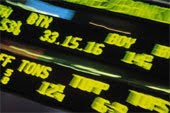 TheStreet.com featured an interesting piece titled “ETFs in Two Flavors: Complex Or Simple.” Here are some highlights followed by my commentary:
TheStreet.com featured an interesting piece titled “ETFs in Two Flavors: Complex Or Simple.” Here are some highlights followed by my commentary:
During the worst of the financial crisis, companies rolled out absolute return funds, which target a specific gain, usually about 6% to 8% a year, regardless of stock- and bond-market conditions. The funds, in the form of mutual funds and exchange traded funds, combine long and short positions.
Now there are many absolute return funds. One company, IndexIQ, went into business, apparently, for the sole purpose of creating exchange traded funds in this niche.
By using a wide range of strategies, absolute return funds are complex. They dampen volatility and offer access to “sophisticated” hedge-fund strategies. The recently listed iShares Diversified Alternatives Trust (ALT) may be the most complex yet. (Technically, it’s not an ETF, but an exchange traded product.)
…
Whatever the success or shortcomings of the Diversified Alternatives Trust turn out to be, there are clearly a lot of moving parts. I’ve written several articles in the past few years about funds that seek to deliver an absolute return.
One I’ve mentioned a couple of times and held on to for clients is the Rydex Managed Futures Fund (RYMFX). The fund goes long or short different commodities and financial futures based on intermediate-term relative strength. That is its only strategy. Hence, it’s much simpler to understand and follow than the Diversified Alternatives Trust.
The concept of generating absolute returns has been around a long time. It has appeal to those investors who are tired of the roller coaster type of investment approach as we have seen over the past couple of years.
Here are the facts: The S&P; lost over 38% in 2008 and gained slightly over 23% in 2009. That still leaves the index at a loss of more than 24% over the past 2 years—not too comforting.
While the theory of earning 6-8% per year sounds good, I have not seen any funds/ETFs that have accomplished that over a longer time period. More importantly, however, it’s the individual investor’s emotional make up which turns out to be his worst enemy.
Here’s what I mean. You may be happy going along and earning 6-8%, then a bull market rally starts, and the major indexes gain over 20%. Now, you no longer are pleased with your 6-8% gain, because you suddenly want a piece of the bigger pie.
However, you can’t have it. The chosen strategy has saved your portfolio from destruction during 2008 and is now lagging the index, which is a normal occurrence. You’re still ahead of everyone else when looking at the past 2 years but, like a stubborn child, you want your cake and eat it too.
This is very similar to trend tracking. Once you avoid a big market drop, you will lag the indexes during the subsequent rebound.
My point is that you need to be realistic as to what you can expect when selecting a particular investment approach; otherwise you will always have the roving eye peeking at returns that could have been.

Comments 3
Ulli,
Your post today really helped me emotionally. Yesterday I was a little disappointed when I compared my 2009 return to my benchmark returns. After reading your post today, I decided to combine my 2008 and 2009 returns. I discovered that I am much better off by using a trend following strategy!
Still following the trends,
Paul G.
Ulli,
Doesn't PRPFX have returns similar to 6-8% over the long term with no down years in the last 10 or so?
Chuck,
If you check the performance history on Yahoo, you will see that 2008 was the only losing year PRPFX has had in the past 10 years.
Ulli…